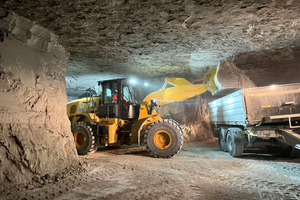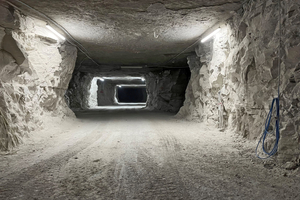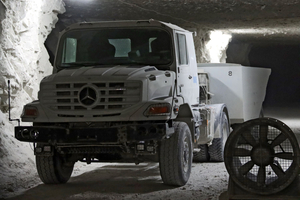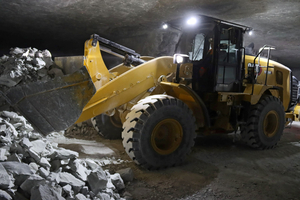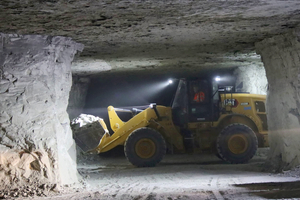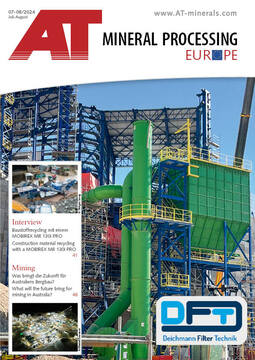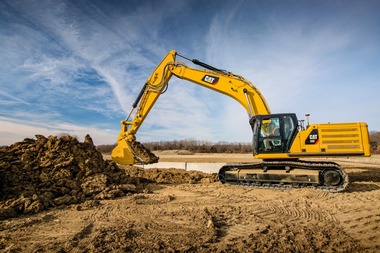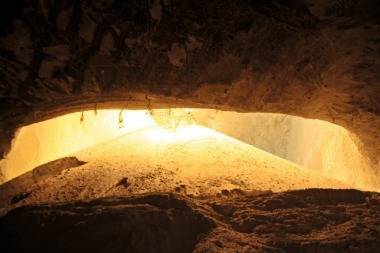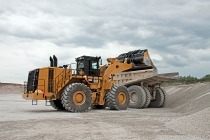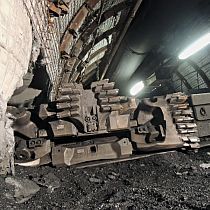950M wheel loaders support Knauf Gips KG in the extraction of anhydrite underground
A conventional underground loader is out of the question for mining. “It would simply be too long to manoeuvre between the caverns. It’s different with the wheel loader in the 20-t class, which has a turning radius of 5.9 m,” explains Henning Jansen, Zeppelin Sales Manager for Group Customers. Zeppelin had already been offering Knauf this solution for several machine generations. The Cat 950M model has been in use at the Hüttenheim plant for a long time. Due to shift work, the machine is operated by different drivers. “To ensure that all drivers have the same working conditions, the same model or generation was chosen again,” was the reasoning behind the procurement. This is because, as a rule, everyone here can operate every machine and so the almost identical machines should make it easier for the drivers to use them.
If only the height of the Cat 950M wasn’t the limiting factor. This applies in particular to loading the trailers with the 3.3 m³ trapezoidal bucket with blade, which has proven itself over the years and was designed by Knauf to meet the mining requirements. The mast must be positioned over the 2 m dropside and the bucket floor must be positioned over the trailer body when tipping the material. But this required a modification. What had already proved its worth on the predecessor machine was taken over or subjected to another test and reconsidered.
The main change concerned the overall height of the machines: service staff at the Zeppelin branch in Erlangen dismantled the cab and relocated and moved the units underneath to create space. This reduced the overall height of the machine by almost 20 cm. To save even more centimetres, the construction machine was fitted with tyres with a smaller diameter (20.5 R25), as they are usually installed on a Cat 938 wheel loader.
These were designed as rock tyres (L5) including an anti-rotation device to minimise the risk of tyre damage or unplanned downtime. “Our tyres used to have chains, but this encouraged dust formation,” says Sven Bauer, Production Manager of the Hüttenheim pit at Knauf. The sharp-edged material has a mechanical effect on the tyres. For this reason, tyres with a tread depth of 74 mm were chosen, which are designed for the extreme operating conditions underground. The tyre shoulders and sidewalls are subjected to particularly high stresses in this application and must be able to withstand impacts, bumps and cuts. And yet, after 200 hours of use, the tread is already showing cracks and chipping, which are unavoidable. To ensure that the tread wears evenly, the front and rear tyres are replaced after around 5000 operating hours.
The roof of the cab is also no ordinary roof, but is designed for use underground to protect the driver from possible stone chipping. Shatterproof safety glazing from the manufacturer Hammerglass was chosen for the windows, which is 300 times stronger than ordinary glass and is fitted all round, contributing to a safe working environment for the operator.
To protect the lifting frame, it was also reinforced with steel plates to prevent cracks from forming in the bolts and bushes in the event of vibrations in the tight conditions. “We implemented this right from the start with the new 950M before delivery,” says Henning Jansen. There was also a learning curve for the 1.4 t counterweight: in the previous machines, it was divided into two parts – now it has been designed with a continuous rear radiator guard, which provides better protection for the radiator, rear and frame. Should the construction machine nevertheless hit a corner, the lights are safe from impact. Other components such as the steering cylinder, lifting cylinder, tipping cylinder, front frame, crankshaft and axle seal were also given extra protection. The mudguards were made of steel and an extra narrow design was chosen for the front tyres. A fire extinguishing system, which the driver can trigger automatically, is to be retrofitted.
The Cat 950M did not make its way to the job site via a shaft, but via a ramp with a height of 3.35 m and a width of 3.60 m – the entrance is almost inconspicuous from the outside. Instead of travelling at 40 km/h, the two loaders move through the mining site at half the speed that was throttled for the operation. “This significantly reduces the vibration load for the employees, which makes driving more pleasant. At the same time, the Cat 950M has a high rim traction force, and this is noticeable in the driving behaviour,” says Sven Bauer.
Minor maintenance work on the vehicles or construction machinery can be carried out underground. Major maintenance work is carried out in the workshop above ground – as is cleaning, as the necessary sedimentation and separation systems are available there.
The deposit is characterised by an 8 m thick anhydrite layer, with only the lower 4 m being mined. Around 200 000 t/a are extracted. The raw material is extracted to a depth of 150 m using the chamber-pillar method. Once the wheel loader has filled its shovel with the loosened rock and dumped it, 10 m long and 6 m wide pillars are left behind. They secure the mine and keep the vault stable. Like a large labyrinth, countless corridors run through the mining site – the underground paths are 6 m wide and 4 m high. Without the LED driving and working lights and rear lights of the construction machinery and other vehicles, everything is shrouded in dark grey. To protect the six-cylinder Cat C7.1 diesel engine with 186 kW from dust, the Cat 950M was therefore fitted with a special cyclone pre-filter. “The fact that the loader is based on the latest Stage V exhaust technology naturally suits us down here,” says Sven Bauer.
Trucks with almost 320 hp act as tractor units in conjunction with the specially designed trailers, which are so flat that they can be loaded with up to 25 t of material in 4 to 5 loading cycles with the Cat 950M. The material is then transported to the crusher, which is around 3 km away from the loading point. The rock is crushed there. It is then transported to the surface by conveyor and processed further – but that is another story.

